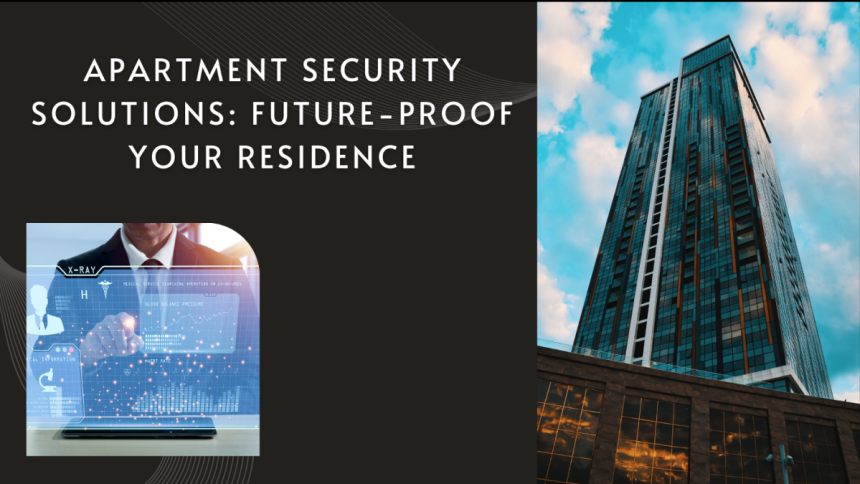Imagine coming back to your apartment building late at night. Thanks to an advanced mobile access system, the main door of the building is instantly unlocked by your smartphone as soon as you approach it. You pass by the AI-powered security cameras, which identify you as a resident and make sure you don’t get reported as a possible invader.
Your apartment’s smart lighting is set to switch on as soon as you arrive, creating the appearance of occupants and discouraging would-be intruders. Sensors are installed throughout the flat to watch for odd activity or environmental threats. If they detect anything, they will promptly notify you and the authorities.
This article looks at ways to incorporate cutting-edge technologies into your home, such as cloud-based monitoring, automated building systems, biometric access controls, and strong cybersecurity. Embrace the future and make your house a secure haven of effectiveness.
Why do we choose Apartments the most?
There are reasons for choosing apartments over flats including price, security, convenience, and amenities, people choose to live in apartments. Long commutes are avoided and quick access to city facilities is made possible by the fact that apartments are frequently situated in metropolitan locations near places of employment, public transportation, dining, shopping, and entertainment venues.
If you live in an apartment, you usually avoid having to deal with things like landscaping, snow removal, and plumbing problems because property management normally takes care of these things. There are lots of facilities in apartments including fitness centers, heated pools, shared areas, and security.
There are security guards, gated entry, and video cameras, which can reassure tenants. Yet, there is a need for the security system for apartment which should be faith-appealing. Compared to owning a house, renting an apartment gives tenants more freedom to move around for personal or professional reasons without having to commit to a long-term mortgage. New developments like AI-driven monitoring and biometric access control will make apartments safer and smarter places to live.
Futuristic Developments in Security Systems
With biometric authentication taking the place of passwords, AI surveillance preventing crimes, and smart sensors enhancing the efficiency and security of households and public areas, these cutting-edge security technologies hold the promise of safer cities in the future.
With the help of these advancements, security will become more proactive rather than reactive, improving everyday safety in all spheres.
Smart Access Control Systems: The First Line of Defense
Integration of Mobile Access
The days of hunting for keys and worrying about misplaced keycards are long gone. The way we enter our houses is being revolutionized by mobile access integration.
- Entry without a key: To simply open your door, use your smartphone.
- Remote access for visitors: Permit visitors to enter temporarily even if you are not physically present
- Increased protection: Digital keys are difficult to copy or steal.
RFID and Biometric Solutions
More than 75% of Americans have utilized biometric technologies, including hand geometry, face recognition, fingerprint scanning, and signature mechanics. Security is being enhanced via RFID technology and biometric technologies. These cutting-edge methods can:
- Each resident should have a distinct identity.
- Access should be easy and rapid while upholding strict security measures.
Integrating access control with other building systems goes beyond mere convenience; it’s about forging a comprehensive security ecosystem.
- By centralizing access control alongside other systems like surveillance and alarms, security management becomes more cohesive and effective. Real-time monitoring and quick response capabilities enhance overall security measures.
- Integration can lead to significant cost savings, potentially reducing operating costs. This efficiency arises from streamlined operations, fewer redundancies, and optimized resource allocation across the integrated systems.
- Integrated systems enable easier management of access permissions, simplified monitoring, and quicker troubleshooting of security issues, fostering a more responsive and user-friendly environment.

Advanced Surveillance and Monitoring: Eyes on Everything
AI-Powered Security Cameras
Active threat detection is replacing passive recording in surveillance thanks to artificial intelligence. Cameras with AI capabilities can:
- Identify questionable activity
- Give security staff alerts in real time.
- Examine trends to anticipate and stop security breaches.
Cloud-Released Video Archiving
Not only is cloud storage practical, but it also revolutionizes security. With cloud-based video storage, you can:
- Watch the video at any time and from any location.
- Gain from improved security via the transmission of encrypted data.
Round-the-clock remote monitoring services
24/7 Remote monitoring services ensure timely detection of abnormalities and quick response to security incidents by providing continuous surveillance and oversight of security systems and surroundings from a distance.
Expert observational services bolster the security of your apartment with one more layer of protection:
- Reaction times to security incidents can reach 60 seconds or less.
- Notable decrease in the likelihood of theft and property damage.
- Comfort in knowing specialists are constantly monitoring.
Intruder Detection and Alarm Systems: Immediate Response to Threats
Intelligent Sensors and Alarms
The intruder-detection systems of today are far superior to those of the past:
- Up to 99% detection accuracy
- Notable decrease in false alarms
- Combining several smart home gadgets for all-encompassing security
Combining Alerts for Mobile Devices
Remain aware of your home’s security wherever you are at all times:
- Get immediate alerts about any security breaches.
- Boost resident reaction times to security-related matters
- Remotely monitor and manage your security system
Automated Reaction Systems
- Cut down on incursion response times
- Lock doors automatically and alert authorities
- Deterrents that trigger, such as lights and alarms
Building Automation for Enhanced Security
Smart Lighting Systems
By creating the appearance of activity within residential buildings by illumination, music, or other indicators, occupancy simulation works to discourage trespassers by making them believe that someone is there.
By minimizing blind spots and guaranteeing clear monitoring of the property, improving visibility entails placing lighting and security cameras both indoors and outside in appropriate locations.
Keeping humidity and temperature within recommended ranges not only encourages energy economy but also guarantees occupant comfort without needless environmental damage, which is important for environmental sustainability.
By enabling centralized monitoring and management, integrated security systems improve overall building security and operational effectiveness. It is possible to identify possible security breaches early on and take preventative action and mitigation steps to protect residents by routinely keeping an eye out for odd trends, such as unexpected patterns in access or activity.
Environmental Sensors
Environmental sensors, such as carbon monoxide monitors and smoke detectors, must be integrated with the security system in a secure apartment complex. When possible dangers like fire or gas leaks are detected by these sensors, quick emergency actions like notifying emergency services or initiating building evacuation procedures are triggered.
By offering early warnings, this integration not only improves tenant safety overall but also guarantees an all-encompassing approach to apartment security that goes beyond simple intrusion detection.
These sensors’ integration with the security infrastructure enables quick and efficient reaction times, reducing hazards and safeguarding the welfare of the occupants.
Cybersecurity Measures: Protecting the Digital Front
Physical safety is not as important as digital security in today’s networked world. Strong encryption prevents unwanted access to residents’ data, and privacy controls on all smart home appliances guarantee that private data is kept safe. To remain ahead of emerging dangers, security processes must be updated regularly.
Proactive measures including using secure passwords, turning on two-factor authentication, and updating firmware to patch vulnerabilities are necessary for securing IoT devices. Whenever feasible, separating IoT devices on different networks offers an additional degree of security.
Giving residents access to easily accessible privacy settings, transparent opt-in procedures for smart services, and cybersecurity best practices education offers them control over their digital security and fosters a safer living environment overall.
The below table shows the improvement of security systems in apartments:
| Feature | Traditional Security | Future-Proof Security |
| Access Control | Keys and keycards | Biometric and mobile access |
| Surveillance | Basic CCTV | AI-powered cameras with analytics |
| Alarm Systems | Standard alarms | Smart sensors with mobile integration |
| Monitoring | On-site security guards | 24/7 remote monitoring with AI assistance |
| Data Storage | Local hard drives | Encrypted cloud storage |
| Environmental Control | Separate systems | Integrated smart building automation |
| Cybersecurity | Basic firewalls | Advanced encryption and IoT protection |
| Sustainability | High energy consumption | Energy-efficient, eco-friendly solutions |
Future Trends in Apartment Security
Artificial Intelligence and Machine Learning
- With its improved capabilities, AI is set to play a bigger role in security and improve safety protocols. AI systems can anticipate possible security problems thanks to predictive analytics, which enables proactive measures to reduce threats before they get worse.
- Artificial intelligence (AI)-driven systems provide more intelligent threat detection by continuously learning and enhancing their capacity to identify and react in real time to changing security threats.
- AI is also capable of generating customized security profiles based on the interests and behavior of each resident, which allows security measures to be optimized to meet specific needs.
- The integration of AI technology into security systems is expected to bring about a revolutionary change in the identification, management, and prevention of risks.
Integration with Smart City Infrastructure
- Connecting residential security systems to larger metropolitan networks is a necessary aspect of integration with smart city infrastructure.
- Upcoming homes will be fully integrated into the city’s security networks, allowing law enforcement to share information in real time and respond to emergencies quickly and efficiently.
- In the future, sustainability will be just as important to security as intelligence. The implementation of energy-efficient security devices is intended to reduce power consumption and promote environmentally sustainable behaviors.
- Encouraging environmental responsibility can be further enhanced by incorporating sustainable materials into security hardware and collaborating with green building initiatives.
- Future apartment security systems will be both technologically and environmentally advanced thanks to this combined focus on smart connectivity and sustainable practices, resulting in safer and greener urban living environments.
Conclusion
Apartment security is changing quickly, and there are lots of interesting new options to safeguard our homes and the people we love. We can design safe, intelligent, practical, and sustainable living environments by adopting these forward-thinking solutions.
The technologies covered in this piece, which range from AI-driven monitoring to integrated building automation, are revolutionizing residential security. Security systems that can evolve and keep up with new threats and technological advancements will be the most successful in the long run.
FAQs
- How do I make sure the smart security system in my apartment isn’t hackable?
Use strong passwords, update firmware frequently, select trustworthy providers with encryption, secure Wi-Fi using WPA3, and think about using a VPN for further protection to protect your smart security system.
- Is it possible to install a personal security system in a flat?
It is possible to establish personal security systems in apartments with gadgets like motion sensors, cameras, and alarms made specifically for apartment living.
- When selecting a remote monitoring service for my apartment, what factors should I take into account?
Think about things like alert dependability, responsiveness of customer service, reputation for data security, and compatibility with your current smart devices when choosing a remote monitoring service for your apartment.
Lynn Martelli is an editor at Readability. She received her MFA in Creative Writing from Antioch University and has worked as an editor for over 10 years. Lynn has edited a wide variety of books, including fiction, non-fiction, memoirs, and more. In her free time, Lynn enjoys reading, writing, and spending time with her family and friends.















